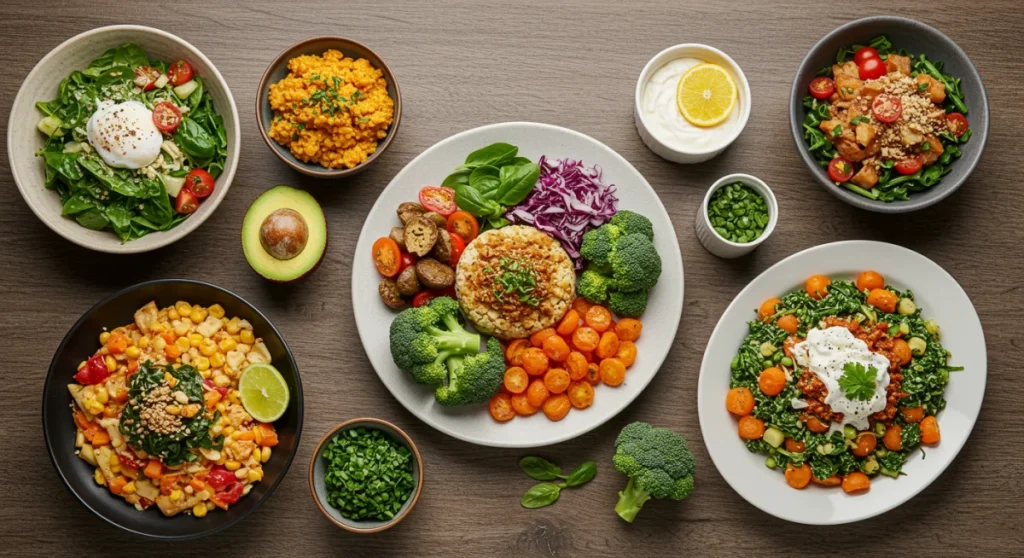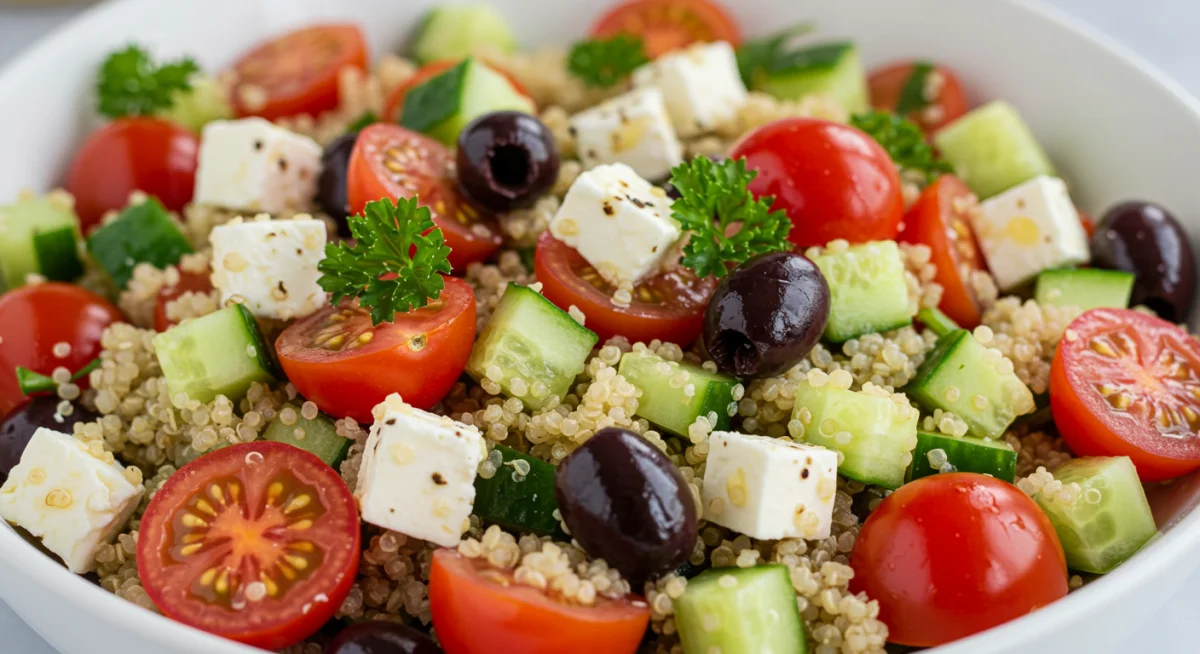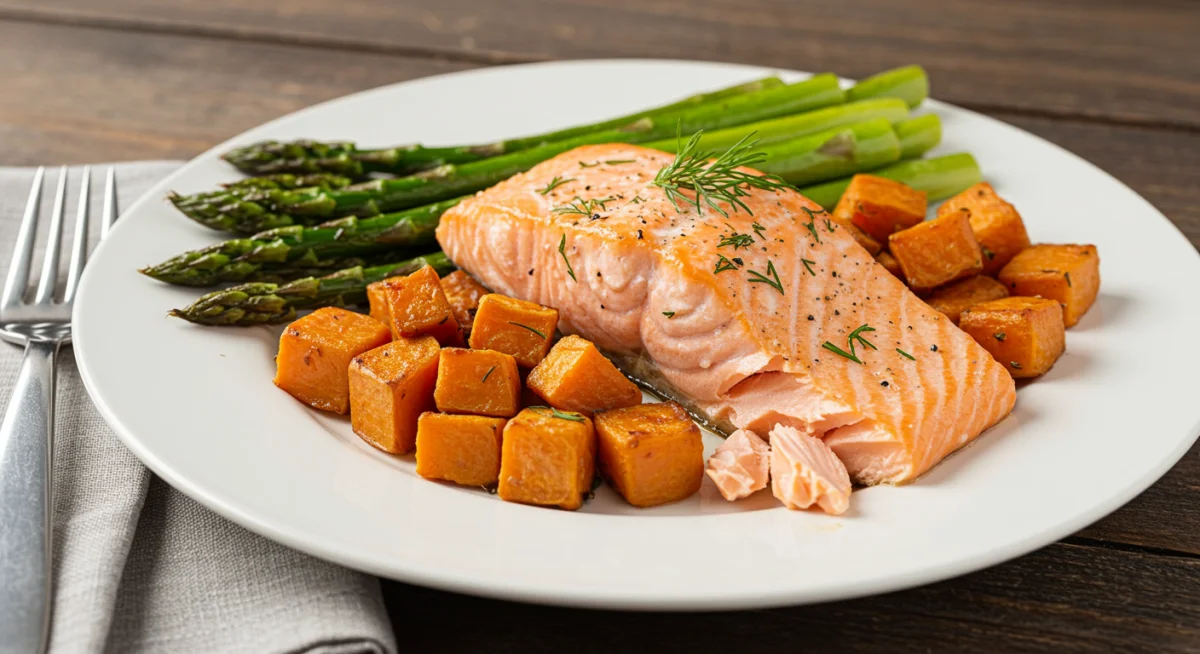USDA Dietary Guidelines 2025: 5 Healthy Recipes to Align Your Meals

The 2025 USDA Dietary Guidelines emphasize personalized nutrition, plant-forward eating, and sustainable choices, offering five essential healthy recipes to help individuals easily align their meals with these updated recommendations for better health.
Are you ready to optimize your plate for the future of health? Understanding and implementing the latest nutritional science is key to long-term well-being. This article will help you in decoding the latest USDA Dietary Guidelines for 2025: 5 essential healthy recipes to align your meals with cutting-edge recommendations for a healthier lifestyle.
Understanding the evolving landscape of dietary guidelines
Dietary guidelines are not static; they evolve as scientific understanding of nutrition deepens. The USDA’s recommendations are pivotal, shaping not only individual eating habits but also public health initiatives and food policies across the United States. Staying informed about these updates is crucial for anyone committed to a healthy lifestyle.
The upcoming 2025 guidelines are expected to build upon previous iterations, likely emphasizing a more holistic approach to diet and health. This often means moving beyond just calorie counting to focus on nutrient density, food sources, and the overall eating pattern. These guidelines serve as a compass, guiding Americans toward food choices that promote health and prevent chronic diseases.
The historical context of USDA guidelines
Since their inception, USDA dietary guidelines have aimed to provide evidence-based recommendations for the general public. Initially focused on preventing nutrient deficiencies, they have broadened their scope to address prevalent health concerns like obesity, heart disease, and diabetes. Each cycle brings new insights and refinements.
- Early guidelines focused on basic food groups.
- Later versions introduced concepts like fat and sugar reduction.
- Recent guidelines highlight eating patterns and sustainability.
Understanding this evolution helps us appreciate the complexity and continuous improvement embedded in these recommendations. The 2025 guidelines are anticipated to be particularly forward-thinking, integrating the latest research on diet, disease prevention, and even environmental impact.
In essence, these guidelines are more than just a list of dos and don’ts; they are a dynamic framework designed to empower individuals to make informed food choices. Our journey into the 2025 guidelines will reveal how simple adjustments to our meals can make a profound difference in our health.
Key themes expected in the 2025 USDA Dietary Guidelines
While the full 2025 USDA Dietary Guidelines have yet to be officially released, expert panels and preliminary discussions offer strong indications of the themes we can expect. These themes reflect current public health challenges and the latest advancements in nutritional science, aiming to provide more personalized and actionable advice.
One significant area of focus is likely to be personalized nutrition. Recognizing that a one-size-fits-all approach isn’t always effective, the guidelines may offer more nuanced recommendations tailored to different life stages, cultural preferences, and health conditions. This shift acknowledges the diversity of the American population and aims for greater inclusivity.
Emphasis on plant-forward eating patterns
A consistent trend in modern nutrition science is the benefits of plant-rich diets. Expect the 2025 guidelines to further advocate for increased consumption of fruits, vegetables, whole grains, nuts, and legumes. This isn’t necessarily about strict vegetarianism, but rather making plants the centerpiece of most meals.
- Increased intake of diverse vegetables and fruits.
- Prioritizing whole grains over refined grains.
- Incorporating plant-based proteins like beans and lentils.
Another crucial theme anticipated is the continued emphasis on reducing added sugars, saturated fats, and sodium. These components are often over-consumed in the typical American diet and are linked to various chronic diseases. The guidelines will likely reinforce strategies for making healthier choices at the grocery store and when dining out.
Sustainability and food systems may also play a more prominent role. There’s a growing recognition of the interconnectedness between diet, health, and environmental impact. While primarily health-focused, the guidelines might subtly encourage food choices that are both nutritious and environmentally responsible, reflecting a broader societal understanding of food’s role.
Recipe 1: Mediterranean quinoa salad with lemon-herb vinaigrette
Our first essential recipe perfectly aligns with the anticipated 2025 USDA Dietary Guidelines’ emphasis on plant-forward eating, whole grains, and healthy fats. This Mediterranean Quinoa Salad is a vibrant, nutrient-dense meal that’s both satisfying and easy to prepare. It’s packed with fiber, vitamins, and antioxidants, making it an excellent choice for any meal.
Quinoa, a complete protein and a whole grain, forms the base of this salad, offering sustained energy and essential amino acids. The colorful array of vegetables not only adds visual appeal but also a spectrum of beneficial micronutrients. The lemon-herb vinaigrette provides a burst of fresh flavor without relying on unhealthy fats or excessive sodium.
Ingredients for a vibrant and healthy meal
Preparing this salad involves simple, fresh ingredients readily available at most supermarkets. The beauty of Mediterranean cuisine lies in its simplicity and reliance on high-quality components. Feel free to adjust quantities based on your preference or availability.
- 1 cup cooked quinoa, cooled
- 1 cup chopped cucumber
- 1 cup cherry tomatoes, halved
- 1/2 cup Kalamata olives, pitted and halved
- 1/4 cup crumbled feta cheese (optional, for a dairy-free version, omit)
- 1/4 cup fresh parsley, chopped
- 2 tablespoons fresh lemon juice
- 3 tablespoons extra virgin olive oil
- 1 teaspoon dried oregano
- Salt and freshly ground black pepper to taste
To prepare, simply combine the cooked quinoa, cucumber, cherry tomatoes, olives, feta (if using), and parsley in a large bowl. In a separate small bowl, whisk together the lemon juice, olive oil, oregano, salt, and pepper to create the vinaigrette. Pour the dressing over the salad and toss gently to combine. This salad can be enjoyed immediately or chilled for later, making it ideal for meal prep.

Recipe 2: Baked salmon with roasted asparagus and sweet potato
This recipe embodies the guidelines’ focus on lean protein, healthy fats, and nutrient-rich vegetables. Baked salmon offers a fantastic source of omega-3 fatty acids, crucial for heart and brain health, while roasted asparagus and sweet potatoes provide ample fiber, vitamins, and minerals. It’s a balanced and flavorful meal that’s surprisingly easy to prepare, perfect for a weeknight dinner.
The simple preparation method, roasting, helps retain the nutrients in the vegetables and coaxes out their natural sweetness. Pairing them with lean protein like salmon creates a complete meal that keeps you feeling full and satisfied, adhering to recommendations for balanced macronutrient intake.
Simple steps for a balanced and delicious plate
The key to this dish is minimal fuss and maximum flavor. You’ll be amazed at how quickly this comes together, making healthy eating accessible even on busy evenings. Adjust seasoning to your taste, but remember the guidelines’ advice on moderate sodium intake.
- 2 salmon fillets (about 6 oz each)
- 1 bunch asparagus, trimmed
- 1 large sweet potato, peeled and cubed
- 2 tablespoons olive oil, divided
- 1 teaspoon dried dill or garlic powder
- Salt and black pepper to taste
Preheat your oven to 400°F (200°C). On a baking sheet, toss the sweet potato cubes with 1 tablespoon of olive oil, salt, and pepper. Roast for 15 minutes. Add the trimmed asparagus to the same baking sheet, tossing with the sweet potatoes. In a small bowl, drizzle the salmon fillets with the remaining 1 tablespoon of olive oil, sprinkle with dill or garlic powder, salt, and pepper. Place the salmon on the baking sheet with the vegetables. Continue roasting for another 12-15 minutes, or until the salmon is cooked through and flakes easily, and the vegetables are tender-crisp. Serve immediately for a wholesome and satisfying meal.
Recipe 3: Lentil and vegetable stew with whole-grain bread
The third recipe, a hearty Lentil and Vegetable Stew, champions the USDA guidelines’ anticipated push for increased legume consumption and diverse vegetable intake. Lentils are a powerhouse of plant-based protein and fiber, making this stew incredibly filling and beneficial for digestive health. It’s also an economical and sustainable meal choice, aligning with broader food system considerations.
This stew is incredibly versatile, allowing you to incorporate a variety of seasonal vegetables, further boosting its nutritional profile. Served with a slice of whole-grain bread, it becomes a complete, comforting meal that adheres to the recommendations for complex carbohydrates and plant-based nutrition.
Building a nutritious and comforting bowl
A good stew relies on a flavorful base and plenty of fresh ingredients. This recipe is designed to be forgiving, so don’t hesitate to substitute vegetables based on what you have on hand or what’s in season. The slow simmering allows the flavors to meld beautifully.
- 1 tablespoon olive oil
- 1 large onion, chopped
- 2 carrots, diced
- 2 celery stalks, diced
- 2 cloves garlic, minced
- 1 cup brown or green lentils, rinsed
- 6 cups vegetable broth
- 1 (14.5 oz) can diced tomatoes, undrained
- 1 teaspoon dried thyme
- 1 bay leaf
- Salt and black pepper to taste
- 2 cups chopped spinach or kale
- Whole-grain bread for serving
In a large pot or Dutch oven, heat the olive oil over medium heat. Add the onion, carrots, and celery, cooking until softened, about 5-7 minutes. Stir in the garlic and cook for another minute until fragrant. Add the rinsed lentils, vegetable broth, diced tomatoes, thyme, and bay leaf. Bring to a boil, then reduce heat, cover, and simmer for 30-40 minutes, or until the lentils are tender. Stir in the spinach or kale and cook until wilted, about 2-3 minutes. Remove the bay leaf before serving. Season with salt and pepper to taste. Serve hot with a slice of wholesome whole-grain bread. This stew is even better the next day as the flavors deepen, making it perfect for meal prepping.
Recipe 4: Chicken and veggie stir-fry with brown rice
Our fourth recipe, Chicken and Veggie Stir-Fry with Brown Rice, offers a quick, customizable, and nutrient-dense option that supports the USDA guidelines’ call for lean proteins and abundant vegetables. Stir-frying is an excellent method for cooking vegetables quickly, preserving their crispness and nutrient content. Brown rice provides complex carbohydrates and fiber, making it a much healthier alternative to white rice.
This dish is incredibly versatile, allowing for endless variations based on seasonal availability and personal preference. The emphasis is on fresh, whole ingredients and a balanced combination of protein, carbohydrates, and healthy fats, ensuring a satisfying and health-conscious meal.
Creating a quick and nutritious weeknight meal
The beauty of a stir-fry is its speed and adaptability. With a little prep work, you can have a delicious and healthy meal on the table in under 30 minutes. Focus on a variety of colorful vegetables to maximize nutrient intake and visual appeal.
- 1 pound boneless, skinless chicken breast, cut into 1-inch pieces
- 2 cups mixed stir-fry vegetables (broccoli florets, bell peppers, snow peas, carrots)
- 1 tablespoon sesame oil
- 2 cloves garlic, minced
- 1 tablespoon grated fresh ginger
- 1/4 cup low-sodium soy sauce or tamari
- 1 tablespoon honey or maple syrup
- 1 tablespoon cornstarch mixed with 2 tablespoons water (for thickening)
- Cooked brown rice for serving
Heat sesame oil in a large skillet or wok over medium-high heat. Add chicken pieces and stir-fry until cooked through, about 5-7 minutes. Remove chicken from the skillet and set aside. Add the mixed vegetables to the skillet and stir-fry for 3-5 minutes, until tender-crisp. Add minced garlic and grated ginger, stirring for another minute until fragrant.
In a small bowl, whisk together the soy sauce (or tamari), honey or maple syrup, and the cornstarch slurry. Pour the sauce into the skillet with the vegetables, stirring constantly until the sauce thickens. Return the cooked chicken to the skillet, tossing to coat everything evenly. Serve immediately over hot brown rice. This meal provides a perfect balance of protein and diverse micronutrients, making it a staple for anyone following the new dietary guidelines.

Recipe 5: Berry and spinach smoothie with protein boost
Our final essential recipe offers a quick, convenient, and incredibly nutrient-dense option that addresses the 2025 USDA Dietary Guidelines’ emphasis on fruit and vegetable intake, along with adequate protein. This Berry and Spinach Smoothie is perfect for a fast breakfast, a post-workout snack, or a mid-day energy boost. It’s an excellent way to incorporate greens and fruits without even noticing them.
The combination of berries provides antioxidants and natural sweetness, while spinach adds a significant dose of vitamins and minerals. Adding a protein source, whether it’s Greek yogurt or protein powder, ensures satiety and supports muscle health, aligning with recommendations for balanced nutrition throughout the day.
Whipping up a power-packed blend
Smoothies are all about customization. Feel free to experiment with different fruits, greens, and protein sources to find your perfect blend. The goal is to create a drink that is both delicious and packed with essential nutrients, making healthy choices effortless.
- 1 cup mixed berries (fresh or frozen)
- 1 cup fresh spinach
- 1/2 cup unsweetened almond milk (or other milk of choice)
- 1/2 cup plain Greek yogurt or 1 scoop protein powder (whey, pea, or hemp)
- 1 tablespoon chia seeds or flax seeds (optional, for extra fiber and omega-3s)
- Optional: a few ice cubes if using fresh fruit
Combine all ingredients in a high-speed blender. Blend until smooth and creamy. If the smoothie is too thick, add a little more almond milk until it reaches your desired consistency. If it’s too thin, add a few more berries or a small amount of ice. Taste and adjust sweetness if necessary, though the berries usually provide enough. This smoothie is a fantastic way to kickstart your day with a significant nutrient boost, ensuring you meet your daily fruit and vegetable targets while getting adequate protein to keep you energized.
Integrating the guidelines into your daily life
Understanding the 2025 USDA Dietary Guidelines is one thing; consistently applying them to your daily life is another. The five recipes provided are a starting point, but the true power lies in adopting a mindset of intentional eating. This involves planning meals, making conscious choices at the grocery store, and being mindful of portion sizes and food quality.
Start small. You don’t need to overhaul your entire diet overnight. Begin by incorporating one or two of these recipes into your weekly rotation. Gradually, as you become more comfortable, you can explore other healthy recipes that align with the guidelines, focusing on whole, unprocessed foods and diverse nutrient sources.
Practical tips for sustainable healthy eating
Making lasting dietary changes requires more than just knowing what to eat; it requires implementing practical strategies that fit into your lifestyle. Consistency is key, and small, manageable steps are often more effective than drastic, short-lived overhauls. Consider how these tips can help you maintain your healthy eating journey.
- Meal Planning: Dedicate time each week to plan your meals, including snacks. This reduces impulsive, unhealthy choices.
- Smart Grocery Shopping: Shop with a list, focusing on the perimeter of the store where fresh produce, lean proteins, and dairy are typically found.
- Portion Control: Be mindful of serving sizes. Use smaller plates, measure ingredients, and listen to your body’s hunger and fullness cues.
- Hydration: Drink plenty of water throughout the day. Often, thirst is mistaken for hunger.
- Cooking at Home: Preparing meals at home gives you control over ingredients, cooking methods, and portion sizes.
Remember, healthy eating is a journey, not a destination. There will be days when you deviate from your plan, and that’s perfectly okay. The goal is progress, not perfection. By consistently striving to make healthier choices and integrating these guidelines into your routine, you’ll build sustainable habits that support your long-term health and well-being. The 2025 USDA Dietary Guidelines are a powerful tool; use them to empower your healthy future.
| Key Guideline Theme | Brief Description |
|---|---|
| Plant-Forward Eating | Emphasizes increased consumption of fruits, vegetables, whole grains, and legumes. |
| Personalized Nutrition | Tailored recommendations considering life stages, cultural preferences, and health conditions. |
| Reduced Unhealthy Fats/Sugars | Strategies to limit intake of added sugars, saturated fats, and sodium for disease prevention. |
| Sustainable Food Choices | Subtly encourages food choices that are both nutritious and environmentally responsible. |
Frequently asked questions about the 2025 USDA Dietary Guidelines
The main goals are to promote health, prevent chronic diseases, and help Americans achieve and maintain a healthy weight. They aim to provide evidence-based nutritional guidance for individuals across all life stages, focusing on overall eating patterns rather than single nutrients.
While building on past recommendations, the 2025 guidelines are expected to emphasize personalized nutrition, a stronger focus on plant-forward eating patterns, and potentially incorporate considerations for sustainable food systems. They aim for more tailored and actionable advice.
The five recipes are designed to be broadly healthy and align with general guidelines. However, individuals with specific dietary restrictions, allergies, or health conditions should consult with a healthcare professional or registered dietitian for personalized advice and modifications.
Ideally, these types of nutrient-dense, whole-food-based recipes should form the foundation of your daily diet. Aim to include them regularly, striving for a balanced intake of fruits, vegetables, whole grains, and lean proteins across most meals and snacks for optimal health benefits.
Once officially released, the complete guidelines will be available on the official USDA website and the Dietary Guidelines for Americans website. These platforms provide comprehensive details, scientific reports, and resources for public and professional use.
Embracing a healthier future through informed choices
The journey toward optimal health is continuous, guided by evolving scientific understanding and practical application. The forthcoming 2025 USDA Dietary Guidelines represent a crucial step in this journey, offering updated, evidence-based recommendations designed to empower Americans to make informed food choices. By understanding the core themes and integrating principles like plant-forward eating, mindful consumption of lean proteins, and reduced intake of processed ingredients, we can significantly improve our well-being.
The five essential recipes shared in this article are more than just meal ideas; they are tangible examples of how to seamlessly align your daily diet with these important guidelines. From the vibrant Mediterranean Quinoa Salad to the power-packed Berry and Spinach Smoothie, each recipe is crafted to be both delicious and incredibly nutritious. Remember that sustainable change comes from small, consistent efforts. Embrace these guidelines as a roadmap to a healthier, more vibrant life, making every meal an opportunity to nourish your body and mind.





